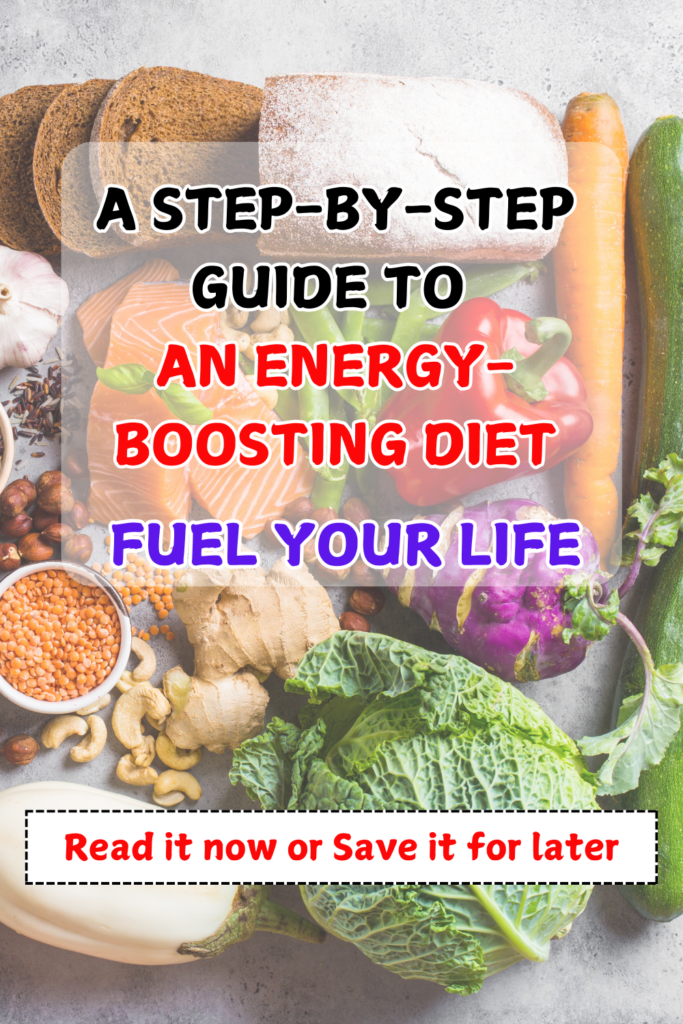Ever feel like you’re dragging through your day, running on empty by mid-afternoon?
It’s time to rethink your diet. What you eat directly impacts your energy levels and overall well-being.
This guide will take you step by step through building an energy-boosting diet to keep you feeling vibrant, focused, and unstoppable.
Why Energy Matters in Your Diet
H2: Food as Your Body’s Power Source
Think of your body as a high-performance engine—it needs quality fuel to run efficiently. The right foods provide the energy to tackle everything from work meetings to workouts.
H2: Benefits of an Energy-Boosting Diet
- Enhanced mental clarity.
- Improved physical performance.
- Reduced fatigue and burnout.
- Better mood and emotional resilience.

Step 1: Start Your Day Right
H3: Importance of a Nutritious Breakfast
Breakfast sets the tone for your entire day. Skipping it can lead to energy crashes and poor focus.

H3: Energy-Boosting Breakfast Ideas
- Oatmeal with Chia Seeds and Fresh Berries: Packed with fiber and antioxidants.
- Avocado Toast with Eggs: Combines healthy fats and protein for sustained energy.
- Smoothie with Spinach, Banana, and Protein Powder: A quick, nutrient-dense option.
Step 2: Focus on Nutrient-Dense Foods
H3: What Are Nutrient-Dense Foods?
These are foods rich in vitamins, minerals, and other nutrients relative to their calorie content.
H3: Examples of Nutrient-Dense Foods
- Leafy Greens: Spinach, kale, and arugula.
- Whole Grains: Quinoa, brown rice, and oats.
- Lean Proteins: Chicken, tofu, and fish.
- Healthy Fats: Avocado, nuts, and seeds.

Step 3: Incorporate Complex Carbohydrates
H3: Why Choose Complex Carbs?
Unlike simple carbs, complex carbs provide a slow and steady release of energy.
H3: Top Sources of Complex Carbs
- Sweet Potatoes: A nutrient-packed alternative to white potatoes.
- Whole-Grain Bread: A versatile base for sandwiches or toast.
- Brown Rice and Quinoa: Perfect side dishes for any meal.
Step 4: Hydrate Strategically
H3: The Role of Hydration in Energy Levels
Dehydration can cause fatigue and reduce physical and mental performance.
H3: Hydration Tips
- Start your morning with a glass of water.
- Aim for 8-10 glasses of water daily.
- Include hydrating foods like cucumbers, oranges, and watermelon.

Step 5: Plan Energy-Boosting Snacks
H3: Why Snacking is Important
Healthy snacks prevent energy dips between meals.
H3: Snack Ideas for Energy
- Trail Mix: A mix of nuts, seeds, and dried fruits.
- Hummus with Veggie Sticks: Combines protein and fiber.
- Greek Yogurt with Honey: A quick protein-rich option.
Step 6: Eat for Your Activity Level
H3: Adjusting Your Diet for Physical Activity
Your energy needs vary depending on how active you are.
H3: Pre-Workout Meals
- A banana with almond butter.
- A slice of whole-grain toast with peanut butter.

H3: Post-Workout Meals
- Grilled chicken with sweet potatoes.
- A smoothie with protein powder and spinach.

Step 7: Limit Energy Drainers
H3: Foods to Avoid
- Sugary Snacks: Cause energy spikes followed by crashes.
- Processed Foods: Low in nutrients and high in unhealthy fats.
- Excessive Caffeine: Can lead to energy crashes and insomnia.
Step 8: Build a Sustainable Meal Plan
H3: Meal Prep Tips for Busy People
- Batch Cook: Prepare meals like quinoa, grilled chicken, and roasted veggies in advance.
- Use Storage Containers: Pack meals and snacks for the week.
- Plan Balanced Meals: Include protein, carbs, and healthy fats in every meal.

Sample Energy-Boosting Meal Plan
H3: Breakfast
- Oatmeal with almond butter and fresh fruit.
H3: Morning Snack
- A handful of mixed nuts and a small apple.
H3: Lunch
- Grilled chicken salad with quinoa, spinach, and avocado.
H3: Afternoon Snack
- Greek yogurt with honey and chia seeds.
H3: Dinner
- Baked salmon with roasted sweet potatoes and steamed broccoli.
Step 9: Monitor and Adjust
H3: Listen to Your Body
Notice how different foods affect your energy levels and adjust accordingly.
H3: Track Your Meals
Keep a journal to identify which foods work best for you.
Conclusion:
An energy-boosting diet isn’t about restriction—it’s about making smarter choices.
By incorporating nutrient-dense foods, staying hydrated, and planning meals that work for your lifestyle.
You’ll fuel your life with sustained energy and vitality.
Remember, food isn’t just fuel but also about it’s the foundation for living your best life.
FAQs
1. What’s the most important meal for energy?
Breakfast kickstarts your metabolism and sets the tone for the day.
2. How can I stay energized without caffeine?
Focus on hydration, complex carbs, and nutrient-dense snacks like nuts and fruits.
3. Are energy bars good for quick energy?
Some are, but choose ones with minimal added sugars and whole ingredients.
4. How much water should I drink daily?
Aim for 8-10 glasses, but adjust based on activity level and climate.
5. Can I maintain energy on a vegetarian diet?
Absolutely! Include plant-based proteins like lentils, quinoa, and tofu, along with healthy fats and whole grains.


